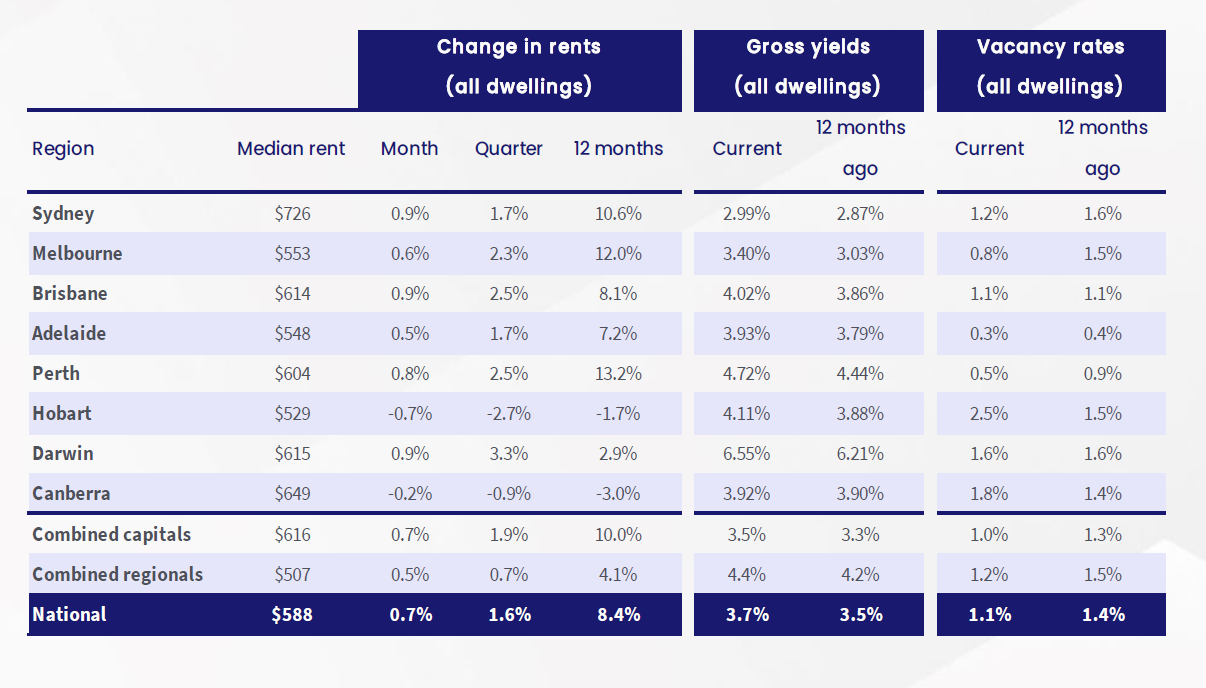

Vacancy rates fell to new record lows across Australia in September despite the easing in the pace of rental growth, CoreLogic has reported.
CoreLogic’s Quarterly Rental Review for Q3 2023 showed rental values increased 1.6% over the September quarter, down from the 2.2% lift recorded in the June quarter as well as from the 2.6% recent peak rate seen over the three months to April. This took the annual pace of growth down from a revised peak of 9.6% in the previous 12 months to 8.4% in the year to September.
However, the ongoing shortfall in rental listings dragged the national vacancy rate to a new record low of 1.1% in September as the total count of national rental listings plunged to its lowest level since early November 2012.
Kaytlin Ezzy (pictured above), CoreLogic economist and report author, said several factors were driving the slowdown in rental growth amid such limited rental availability, with worsening affordability a significant factor placing downward pressure on the pace of rental growth in recent months.
“After recording a small dip over the first few months of COVID, national rents have risen for 38 consecutive months, taking rental values 30.4% higher since July 2020 and adding the equivalent of $137 to the median weekly rent,” Ezzy said. “With the rising cost of living adding additional pressure on renter’s balance sheets, it is likely tenants have hit an affordability ceiling, seeking to grow their households to share the growing rental burden.
“The situation of low rental vacancy rates and insufficient housing supply is [a] broad issue impacting regions around the country to different extents. Record-high net overseas migration, fuelled by a combination of an increased flow of new arrivals and weaker departure numbers, coupled with a continued shortfall in rental listings, saw the vacancy rates falling to new record lows across both the combined capitals (1%) and combined regional markets (1.2%).”
Over the four weeks to Oct. 1, just 90,153 properties were listed to rent nationally – the lowest level since early November 2012. This equates to a rental shortfall of roughly 47,500, with total listings down -15.1% compared to the levels seen this time in 2022 and -34.5% below the previous five-year average.

Rental growth across the capital cities continued to outpace the combined regionals, with rents lifting 1.9% and 0.7%, respectively, over the third quarter. The pace of rental appreciation slowed down in both markets over the quarter, dropping -80 basis points across the capitals and -10 basis points across the regions, CoreLogic said.
Rental growth for houses picked up pace over Q3, up 1.7%, compared to unit rents’ 1.3%
“Since peaking at 4.3% over the three months to April, the pace of quarterly rental growth across Australia's unit sector has plummeted by more than two-thirds taking the gap between the median house and median unit rents from $33 in May to $36 in September,” Ezzy said.
“Worsening affordability in the unit sector, coupled with a potential shift towards larger rental households, has likely helped rebalance demand between the two property types. Much of the unit sector's relative affordability has been eroded through the recent rental surge, with unit rents rising 11.7% over the past 12 months compared to the 7.1% rise in house rents.”
The pace of rental appreciation over the quarter was diverse across the capitals, with Darwin recording the strongest quarterly rise in dwelling rents at 3.3%, followed by Brisbane at 2.5%.
In contrast, rental conditions eased in Perth (2.5%), Melbourne (2.3%), Sydney (1.7%), and Adelaide (1.7%), while rents across Hobart (-2.7%) and Canberra (-0.9%) fell.
Sydney continued to hold the crown as the most expensive capital city rental market, with median dwelling rent at $726 per week. This was followed by Canberra ($649p/w) and Darwin ($615p/w).
Holding the most affordable rental capital title, on the other hand, was Hobart ($529 p/w), overtaking Adelaide ($548p/w), which recorded a quarterly rental rise equivalent to $9 p/w while Hobart rents fell -$15 p/w.
With the quarterly trend in national values (2.2%) outpacing quarterly growth in national rents (1.6%), national gross rental yields slightly contracted over the quarter, falling three basis points to 3.69% in August before rising two basis points to 3.71% in September.
While down two basis points from the recent peak seen in April (3.73%), national gross yields were still 20 basis points above those recorded this time in 2022 (3.51%) and 55 basis points above the recent low recorded in January 2022 (3.16%), CoreLogic reported.
To download a full copy of the CoreLogic’s Quarterly Rental Review for Q3 2023, click here.
Get the hottest and freshest mortgage news delivered right into your inbox. Subscribe now to our FREE daily newsletter.
